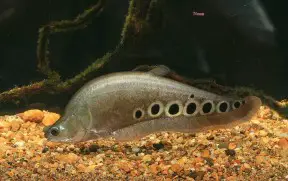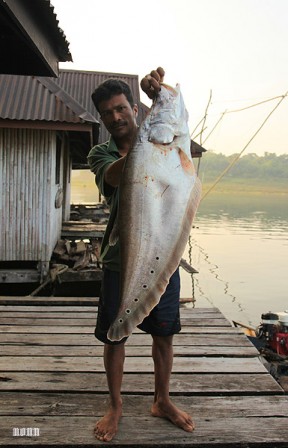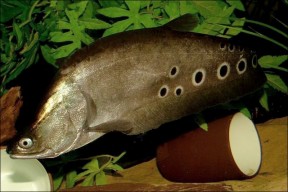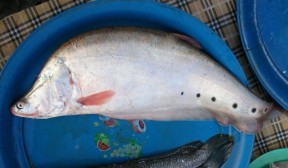Chitala ornata
Clown Featherback
SynonymsTop ↑
Notopterus ornatus Gray, 1831; Notopterus ocellifer Bleeker, 1864 (nomen nudum)
Etymology
Chitala: a Bengali vernacular name for members of this genus.
ornata: from the Latin ornatus, meaning ‘adorned, decorated’, in reference to this species’ colour pattern which consists of large, ocellated spots on the posterior part of the body.
Classification
Order: Osteoglossiformes Family: Notopteridae
Distribution
Native to the Mae Klong, Chao Phraya, and Mekong river systems in Thailand, plus the Mekong basin in Laos, Cambodia, and Vietnam.
It has been introduced to Myanmar and the Philippines, where it is cultured for food, and the U.S.A., where a population has become established in Palm Beach County, Florida state.
Type locality was given simply as ‘Indian Seas’.
Habitat
Inhabits lower parts of rivers and tributaries, swamps, floodplains, and lakes, including some man-made dams to which it seems well-adaptable. Moves into areas of flooded forest to spawn.
It is thought to be threatened by dam construction and other anthropogenic habitat alterations.
Maximum Standard Length
800 – 1000 mm.
Aquarium SizeTop ↑
Suitable only for public installations or the very largest, highly-specialised private aquaria.
Maintenance
Prefers dim lighting and access to refuges in the form of driftwood, large rocks or lengths of plastic piping.
A large, mature filter system, rigorous maintenance regime comprising weekly water changes of 50-70% tank volume, and provision of highly-oxygenated water with a degree of movement should be considered mandatory.
Water Conditions
Temperature: 20 – 28 °C
pH: 6.0 – 8.0
Hardness: 36 – 268 ppm
Diet
An obligate, typically nocturnal, predator feeding on smaller fishes, crustaceans and other invertebrates in nature but in most cases adapting well to dead alternatives in captivity.
Young fish can be offered chironomid larvae (bloodworm), small earthworms, chopped prawn and suchlike while adults will accept strips of fish flesh, whole prawns/shrimp, mussels, live river shrimp, larger earthworms, etc., as well as dried pellets although the latter should not form the staple diet.
This species should not be fed mammalian or avian meat such as beef heart or chicken since some of the lipids contained in these cannot be properly metabolised by the fish and may cause excess fat deposits and even organ degeneration.
Similarly there is no benefit in the use of ‘feeder’ fish such as livebearers or small goldfish which carry with them the risk of parasite or disease introduction and at any rate tend not have a high nutritional value unless properly conditioned beforehand.
Behaviour and CompatibilityTop ↑
Relatively peaceful with fishes too large to be considered prey but can be territorial with conspecifics and other similarly-shaped species, especially if space is at a premium.
Sexual Dimorphism
Unreported.
Reproduction
Unreported in captivity but in nature male individuals contruct nests from branches and leaves and remains to guard the eggs and fry post-spawning, which takes place in areas of flooded forest during the wet season.
NotesTop ↑
This species is also referred to as ‘clown knifefish’ in the aquarium trade but arguably has no place in the ornamental hobby given its adult size and specialised requirements. It remains inexplicably popular, however, with albino and leucistic forms having been line-bred for the purpose while apparent hybrids with C. blanci also appear from time-to-time.
It can be distinguished from all congeners by presence of one or more rows of large ocellated spots above the base of the anal-fin, but is regularly misidentified as the congener C. chitala both in the aquarium trade and hobbyist literature. C. chitala is easily distinguished since it possesses non-ocellated spots above the anal-fin and is the only member of the genus in which a series of transverse gold or silver bars is normally present on the dorsum.
Notopterids are distributed in Africa and Southeast Asia and all possess an elongated anal-fin which is continuous with the caudal-fin, a ‘humped’ appearance, very small scales, plus the ability to breathe atmospheric air.
References
- Gray, J. E., 1831 - Zoological Miscellany 1831: 16
Description of three species of Notopterus, found by Gen. Hardwicke, in the Indian seas. - Kottelat, M., 2013 - The Raffles Bulletin of Zoology Supplement 27: 1-663
The fishes of the inland waters of southeast Asia: a catalogue and core bibliography of the fishes known to occur in freshwaters, mangroves and estuaries. - Kottelat, M., 2001 - WHT Publications, Colombo: 1-198
Fishes of Laos. - Page, L. M. and B. M. Burr, 2011 - H.M.H. Books: 1-663
Peterson Field Guide to Freshwater Fishes of North America North of Mexico (Second Edition). - Rainboth, W. J., 1996 - FAO, Rome: 1-265
FAO species identification field guide for fishery purposes. Fishes of the Cambodian Mekong.





